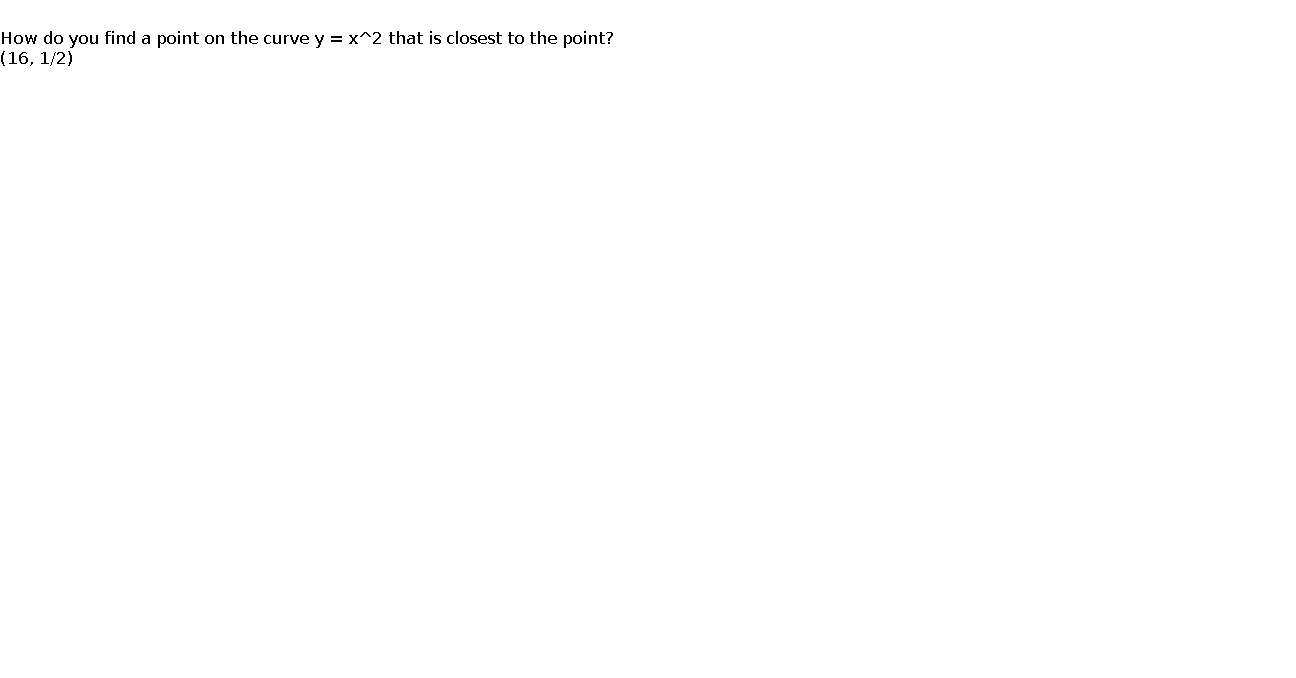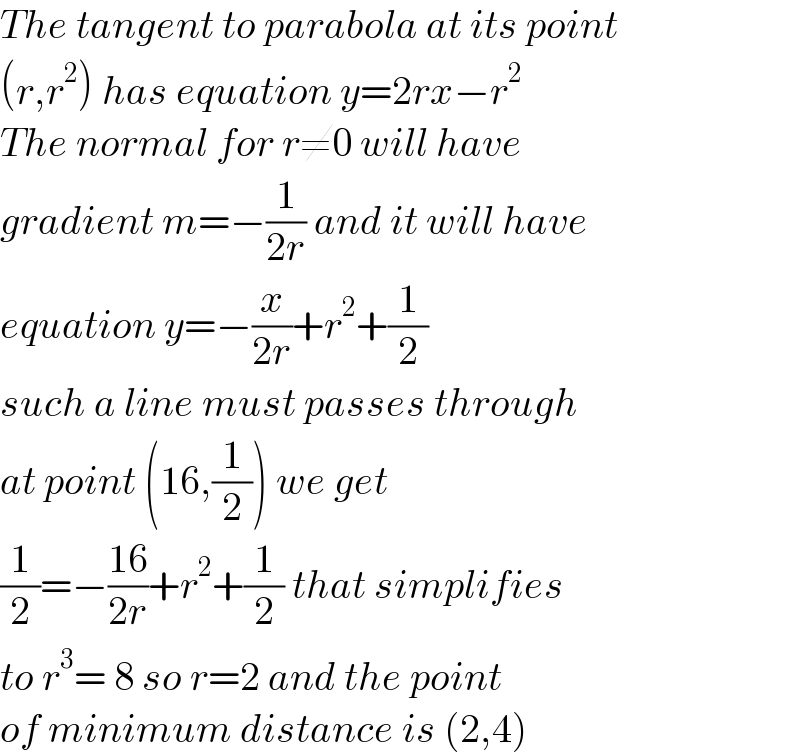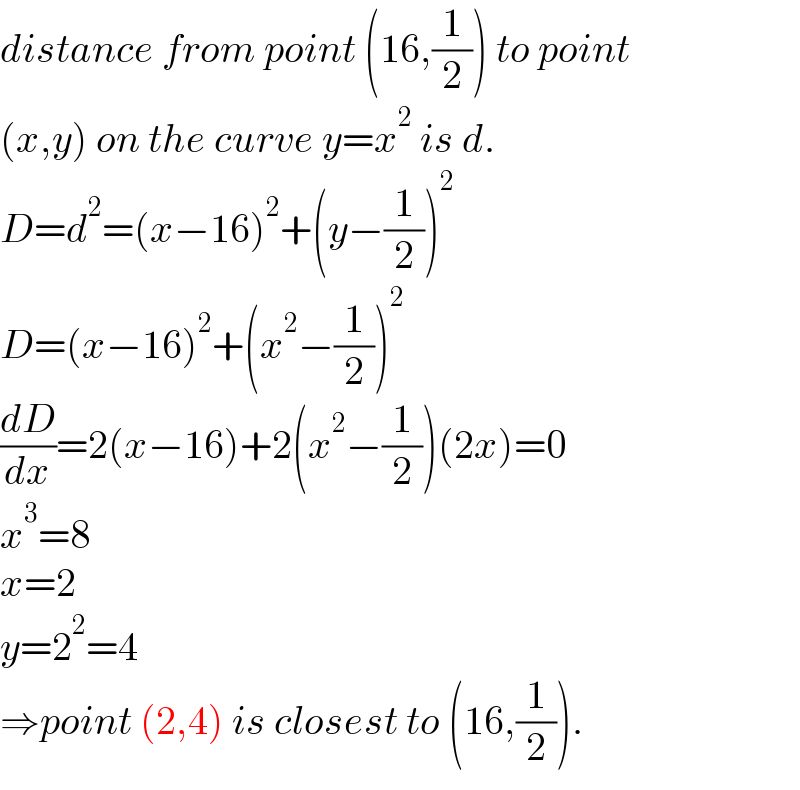
Question Number 139255 by bobhans last updated on 25/Apr/21

$$ \\ $$ How do you find a point on the curve y = x^2 that is closest to the point? (16, 1/2)\\n
Answered by john_santu last updated on 25/Apr/21

$${The}\:{tangent}\:{to}\:{parabola}\:{at}\:{its}\:{point} \\ $$ $$\left({r},{r}^{\mathrm{2}} \right)\:{has}\:{equation}\:{y}=\mathrm{2}{rx}−{r}^{\mathrm{2}} \\ $$ $${The}\:{normal}\:{for}\:{r}\neq\mathrm{0}\:{will}\:{have} \\ $$ $${gradient}\:{m}=−\frac{\mathrm{1}}{\mathrm{2}{r}}\:{and}\:{it}\:{will}\:{have} \\ $$ $${equation}\:{y}=−\frac{{x}}{\mathrm{2}{r}}+{r}^{\mathrm{2}} +\frac{\mathrm{1}}{\mathrm{2}} \\ $$ $${such}\:{a}\:{line}\:{must}\:{passes}\:{through} \\ $$ $${at}\:{point}\:\left(\mathrm{16},\frac{\mathrm{1}}{\mathrm{2}}\right)\:{we}\:{get}\: \\ $$ $$\frac{\mathrm{1}}{\mathrm{2}}=−\frac{\mathrm{16}}{\mathrm{2}{r}}+{r}^{\mathrm{2}} +\frac{\mathrm{1}}{\mathrm{2}}\:{that}\:{simplifies} \\ $$ $${to}\:{r}^{\mathrm{3}} =\:\mathrm{8}\:{so}\:{r}=\mathrm{2}\:{and}\:{the}\:{point} \\ $$ $${of}\:{minimum}\:{distance}\:{is}\:\left(\mathrm{2},\mathrm{4}\right) \\ $$
Answered by mr W last updated on 25/Apr/21

$${distance}\:{from}\:{point}\:\left(\mathrm{16},\frac{\mathrm{1}}{\mathrm{2}}\right)\:{to}\:{point} \\ $$ $$\left({x},{y}\right)\:{on}\:{the}\:{curve}\:{y}={x}^{\mathrm{2}} \:{is}\:{d}. \\ $$ $${D}={d}^{\mathrm{2}} =\left({x}−\mathrm{16}\right)^{\mathrm{2}} +\left({y}−\frac{\mathrm{1}}{\mathrm{2}}\right)^{\mathrm{2}} \\ $$ $${D}=\left({x}−\mathrm{16}\right)^{\mathrm{2}} +\left({x}^{\mathrm{2}} −\frac{\mathrm{1}}{\mathrm{2}}\right)^{\mathrm{2}} \\ $$ $$\frac{{dD}}{{dx}}=\mathrm{2}\left({x}−\mathrm{16}\right)+\mathrm{2}\left({x}^{\mathrm{2}} −\frac{\mathrm{1}}{\mathrm{2}}\right)\left(\mathrm{2}{x}\right)=\mathrm{0} \\ $$ $${x}^{\mathrm{3}} =\mathrm{8} \\ $$ $${x}=\mathrm{2} \\ $$ $${y}=\mathrm{2}^{\mathrm{2}} =\mathrm{4} \\ $$ $$\Rightarrow{point}\:\color{mathred}{\left(}\mathrm{\color{mathred}{2}}\color{mathred}{,}\mathrm{\color{mathred}{4}}\color{mathred}{\right)}\:{is}\:{closest}\:{to}\:\left(\mathrm{16},\frac{\mathrm{1}}{\mathrm{2}}\right). \\ $$
